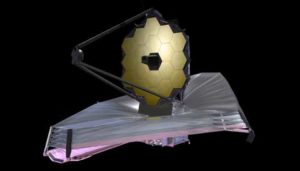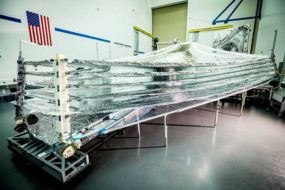Despite significant cost overruns, NASA's James Webb Space Telescope is now set for a March 2021 launch — assuming it receives Congressional reauthorization.

NASA has announced a commitment to a March 30, 2021, launch date for its James Webb Space Telescope. The new date is a 29-month delay from the original October 2018 date established back in 2011. It’s also almost a year later than the May 2020 date that NASA tentatively announced earlier this year.
The announcement comes with the release of a report from an independent review board, which affirmed both the telescope’s complexity and the range of factors affecting its schedule of development. The report, as well as NASA’s responses to its recommendations, is available here. (If you’re interested in what it takes to make a world-class telescope, it makes for a surprisingly fascinating read!)
The new report also puts a new price tag on the mission: $8.8 billion, which exceeds the $8 billion cap placed by Congress in 2011. This means that the mission will face Congressional reauthorization. While NASA has the funds necessary to implement the review board’s recommendations for 2018 and 2019, the agency will need Congress to approve additional funds for 2020 and 2021.
What the Review Board Found

Northrop Grumman Corporation
Webb promises a new view of the infrared universe, granting astronomers access to the dawn of star and galaxy formation as well as the ability to probe the atmospheres of nearby exoplanets. But the unprecedented images expected from this mission come with a high level of engineering complexity and ballooning cost.
While the astronomical instruments for Webb are ready to go, the spacecraft bus itself and the sunshield designed to protect the infrared instruments from the Sun’s heat are still in a process called “integration and testing.” Numerous issues have cropped up during this phase. Although integration and testing are designed to detect problems, delays have come at the cost of approximately $1 million per day.
Some of the problems were minor at first glance, but because of Webb’s complexity, have had inordinate impact. One problem discovered during testing last year was that the fasteners containing the hair-thin sunshield membrane had snagged, tearing holes in the membrane. The membranes were repaired, but to ensure this problem doesn’t occur during the mission itself, the fastening lock nuts were tightened only to be flush with their bolts.
But that wasn’t tight enough — during acoustics testing, which simulates conditions during launch, 70 pieces of hardware came loose. While most pieces were subsequently found, two are believed to still be inside the spacecraft. This problem alone has caused about six months of delays.
Human errors have also been part of the problem. In NASA’s previous report in March, the agency acknowledged two mistakes that caused significant delays while testing the propulsion system: an incorrect solvent was used to clean valves, which destroyed the valves that then needed to be repaired/replaced and reinstalled, and improper wiring delivered excessive voltage to a transducer, which also had to be replaced. Both of these problems could have been avoided, says Tom Young, chair of the independent review board, had the proper processes and the discipline to follow them been in place.
The review board has made more than 30 suggestions to address these errors, as well as other factors that are impacting Webb’s schedule, including “excessive optimism,” system complexity, and inexperience with new systems such as the five-layered sunshield, in order to ensure a successful launch in March 2021. NASA has fully endorsed the review board’s evaluation and has already implemented or begun implementing most of these items. NASA and the independent review board both conclude that Webb's incredible science potential makes mission success critical. "Webb will be worth the wait," says Thomas Zurbucken, associate administrator of NASA Science Mission Directorate.
Meanwhile, testing and integration of the spacecraft element continues. Once this phase is complete, around October, the telescope and science instruments will be integrated on the spacecraft and the whole shebang will undergo environmental testing and a final deployment test before it’s shipped to Kourou, French Guiana, for launch.
 13
13









Comments
Anthony Barreiro
June 29, 2018 at 4:27 pm
Uh oh. Now we need to feed these new dates into the linear regression equation:
Julian date of prediction = 2458296
Julian date of predicted launch = 2459303
Should I change my office pool bet? Or should I stick with October 19, 2023?
You must be logged in to post a comment.
Bob
June 29, 2018 at 6:39 pm
This is just embarrassing!
We need JFK back, he knew how to set an end date for a large space project.
You must be logged in to post a comment.
Jim DeCamp
July 1, 2018 at 4:39 pm
Tell that the widows of Grissom, White, and Chaffee. A crash program resulted in fatalities. Hubble could have been a catastrophe if it was not serviceable by the Space Shuttle, which no longer exists. Webb is going into the L2 earth-moon Lagrange point. There is no do-over, no servicing mission, no second chance, it has to be done right the first time.
NASA at times seems to have lost sight of its mission, and is being used for other purposes.
You must be logged in to post a comment.
bwana
June 30, 2018 at 2:44 am
We're working from a 2011 design! Hell, by the time this thing gets launched in 2021, if it happens then, its technology will be ten years old, essentially a very expensive antique before it even gets into the heavens...
You must be logged in to post a comment.
Robert-McCabe
June 30, 2018 at 2:12 pm
Agreed!
This thing has become an incredibly expensive boondoggle!
You must be logged in to post a comment.
Anthony Barreiro
July 5, 2018 at 8:51 pm
The Voyagers, with 45 year old technology, are still returning data that is changing our understanding of the solar system and the larger neighborhood. Opportunity, at least until the recent dust storm, is what, 14 years into a projected 90 day mission? One advantage of using technology that has been out of beta testing for more than a month is that you know it works. The 200 inch Hale telescope on Mt. Palomar wasn't finished until after George Hale died. Let's be patient.
You must be logged in to post a comment.
Michal Warzecha
August 28, 2019 at 3:13 pm
That is actually common. NASA never uses state of the art tech due to reliability. There is a technology freeze years ahead of a design. Failure analysis is a critical aspect of aerospace systems design.
For example, New Horizons, though launched in 2006, was largely made from 90s tech. The shuttles flew through the 90s with 1970s computers because it had proven reliability. Why have a cutting edge computer that will blue screen when a 70s iron core has 100% reliability?
You must be logged in to post a comment.
Mofo
July 8, 2020 at 3:02 pm
I realize I'm a tad late to the discussion.
NASA has a doc on this issue. The process is called NASA Electronic Parts & Packaging (NEPP) Program.
https://ntrs.nasa.gov/archive/nasa/casi.ntrs.nasa.gov/20050180611.pdf
It's exactly as you said. the parts are all Mil Spec. and mature. Reliability is obviously paramount.
You must be logged in to post a comment.
Robert-McCabe
June 30, 2018 at 2:13 pm
Another delay, most cost overruns...
I'm going to be retired before this this ever takes off.
You must be logged in to post a comment.
Peter Wilson
July 2, 2018 at 9:32 am
On the plus-side, the infrared universe from the dawn of time will still be there, whenever it launches...
You must be logged in to post a comment.
Anthony Barreiro
July 5, 2018 at 8:42 pm
Indeed. Let's keep this mission in perspective.
You must be logged in to post a comment.
staceyanne17
March 3, 2019 at 7:49 pm
I don't understand your math. If Webb is launched in March 2021, technology is two and a half years out of date, not ten, based on original launch date of Oct 2018. These things are not doddled on a cocktail napkin and slingshotted into space the following week.
You must be logged in to post a comment.
Oscar
July 14, 2019 at 2:06 am
modus operandi: methodical and thorough- will justify a positive outcome.
You must be logged in to post a comment.
You must be logged in to post a comment.